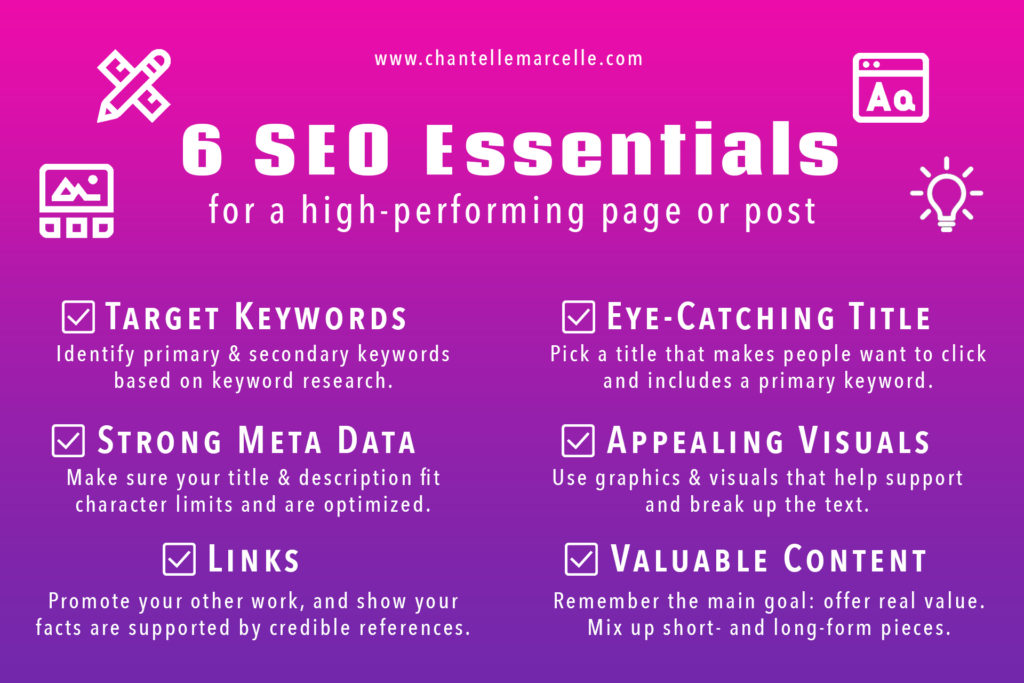

SEO Basics: The Best SEO Crash Course & Checklist
Effective search engine optimization (SEO) strategy is a key part of having the best website. Without making sure you have a solid introduction to the SEO basics, your website traffic and conversions are going to suffer.
Here are 5 must-have blocks you need in the foundation of your SEO strategy.
1. Create a sitemap.
Search engines like Google want detailed instructions on how your website is structured and how you’d like them to present your pages. A sitemap is a document that gives this information in a straightforward, standard manner. It basically looks like a simple hierarchy chart.
You want to create a formatted directory including all the pages and files available for search engines to display. What’s cool is there are tools that will automatically generate a sitemap for you, like this one.
If you use WordPress, I highly recommend installing the Yoast plugin, which will help manage this task for you.
2. Register an SSL certificate.
Data security ranks among the top priorities for website visitors. According to SSL.com, “SSL (Secure Sockets Layer) and its successor, TLS (Transport Layer Security), are protocols for establishing secure links between networked computers.”
Basically if you have an SSL certificate for your website, you’re letting everyone know that your website has an extra measure of protection. In 2018, Google started letting website visitors know which sites are secured by an SSL and which aren’t.
Why do I mention all this technical stuff?
Websites with an SSL certificate receive priority treatment when it comes to feature on SERPs (search engine result pages). Google boosts the rank of secured pages over unsecured.
Buy an SSL certificate to make sure you aren’t being penalized.
3. Write strategic metadata.
This is an important part of SEO basics. Every page on your website that you want to rank for keywords needs to have the appropriate metadata.
What is metadata?
It’s information that you provide about a webpage, images, and files that provides important details for users about what to expect. This includes:
- Title
- Description
- Alt-tag (this is what appears for an image that hasn’t loaded to the page so users know what the image actually is, even if it fails to appear)
The title and description are important because that’s what appears on SERPs and lets searchers know more about a page before they click on it. If your title and description aren’t well written, they won’t catch interest. And if you don’t include a title and description, the search engine will decide what to populate for your page in search results.
4. Perform keyword planning.
Now we’re getting to the good stuff! I’m sure you’ve heard of keywords. They’re the terms, phrases, and questions you want your website to rank for on search engine results pages.
Whether your focus is digital marketing or content marketing, every marketer should be planning and tracking keywords.
Most importantly, you don’t want multiple pages on your site competing for the same keywords. It just doesn’t make sense. You can be much more effective if you organize your web pages to each go after a different set of keywords to make sure you’re covering your ground.
It’ll also help you determine what new content is needed and measure improvements in your rankings over time.
Want to know where to start with keyword research?
Google offers a great keyword search tool if you open a free Google Ads account.
5. Add plenty of new content.
This is one of the biggest SEO mistakes I see, especially at small companies with limited marketing resources.
Not making it a priority to consistently add new content is an SEO fail.
Google rewards websites that are constantly adding relevant, fresh content. It’s why a blog is one of the most powerful tools of your SEO strategy. Your blog is where you’ll find the most opportunity to publish new content and expand your keyword targeting.
The more new content you add, the better. Just make sure it’s high-quality content and not filler. Google algorithms advance daily in their ability to weed out the garbage and deliver only the best content on the first pages of search results.
Want to talk more about email and how to use marketing automation to improve customer experience? Add me on LinkedIn or tweet me!
You can also sign up for my newsletter and get my content (plus other insight) delivered to you weekly.



